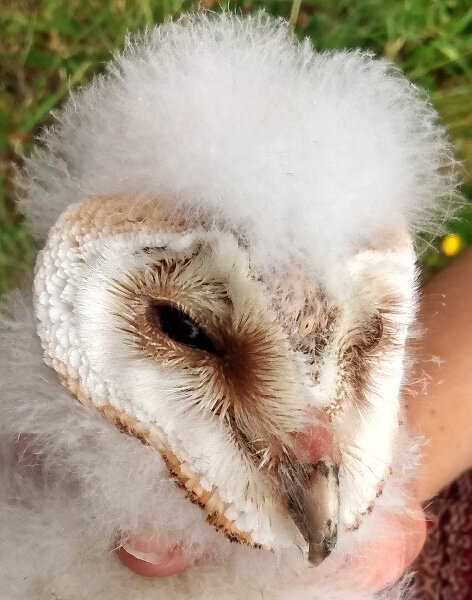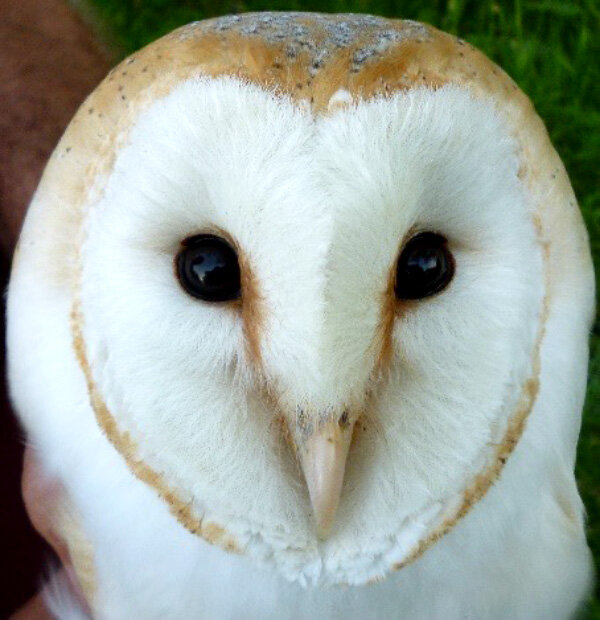by Richard Clarke of the Gwent Ornithological Society and Goldcliff Bird Ringers
Usually the cry is of “bats in the belfry”, but at St Cadwaladr’s we have something else stirring upstairs – Barn Owls.
This year, with the help of members of the Goldcliff Ringing Group (the Group) we were able to confirm that not only have Barn Owls been roosting in the church tower but that they have also bred successfully - with at least one owlet having fledged successfully.
Barn Owls have historically been associated with Churches and some people still refer to the species as the Church Owl. Perhaps surprisingly given the high number of churches in south east Wales, there are very few records of Barn Owls associated with them. St Cadwaladr’s is thought to be the only current church breeding site in the Gwent area.
Birds at St Cadwaladr’s nested on one of the high ledges in the tower. As noted previously, breeding was successful this year however the level of success might have been greater. The nesting ledge proved hazardous, with an egg being found below the ledge smashed on the floor. To help improve matters going forward the Group has built and installed a nesting box which hopefully will provide a safer nesting site.
The Barn Owl is an iconic species that has special protection under the Wildlife and Countryside Act, 1981. Nesting birds, their nests, eggs and young are fully protected at all times. The species has previously suffered significant population declines and in the last Century it was adversely affected by organochlorine pesticides such as DDT in the 1950s and 1960s. Today’s main threats/limiting factors are a loss of suitable habitat, collision on busy roads, poisoning through the use of rodenticides and the loss (or absence) of available nest sites.
Owlet (Richard M Clarke)
St Cadwaladr’s is part of a wider project being furthered by the Group which aims to help maintain and where possible, increase the population of barn owls by providing nest boxes. With the financial support of the Living Levels, Welsh Government and the Monmouthshire and Newport Local Nature Partnership the Group has been providing suitable/safe nesting sites in areas where there is good habitat nearby.
To date, over 50 nest boxes have been erected in southern Gwent. The benefits of this action are now showing. In 2019, five breeding pairs occupied boxes and three other boxes were used by roosting birds. Last year there were six breeding pairs, four of which raised juveniles successfully and other boxes were being used by roosting birds. This year, ten breeding pairs used nest boxes and a further four boxes being used for roosting.
Most nest boxes have been put in barns or on free-standing trees with a few at rural churches. In addition to St Cadwaladr’s, customised nest boxes have been installed at St Peter’s Newchurch, St Mary’s Llanwern and St Peter’s Henllys with discussions ongoing at other churches.
Barn Owls will continue to be monitored at St Cadwaladr’s. Plans are also in hand to continue to support the birds during future church renovation work and an external nest box will be provided in the church grounds to provide temporary accommodation should access to the tower need to be closed when work is underway.
The Group is continuing to look for new sites in Gwent where Barn Owls might be encouraged to breed and would be happy to hear from landowners who would be interested in housing a nest box. Please contact Richard Clarke at chykembro2@aol.com or 07977 698255.
Barn owl (Richard M Clarke)


